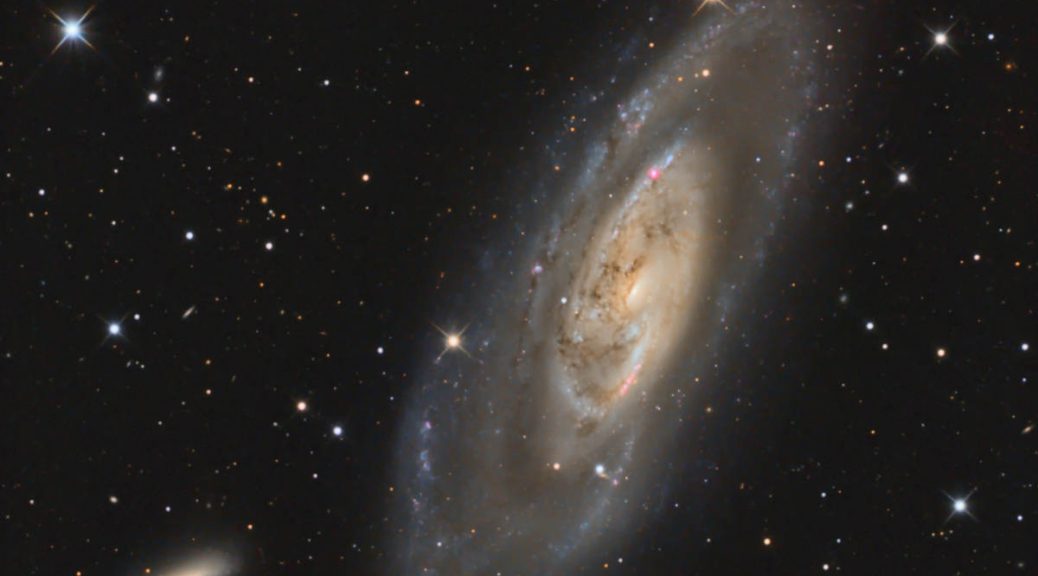Field Centred at:
RA: 12h 18m 41.0s
Dec: +47° 17′ 57.3″
Field 25.2×18.9 arcmin, Up is 184° E of N
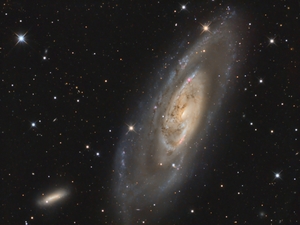 M106 (NGC 4258) is an intermediate type spiral galaxy located at a distance of 23.7 (± 1.5) million light years in the constellation of Canes Venatici. Also shown in this frame is the small spiral galaxy NGC 4248 (lower left of frame).
M106 (NGC 4258) is an intermediate type spiral galaxy located at a distance of 23.7 (± 1.5) million light years in the constellation of Canes Venatici. Also shown in this frame is the small spiral galaxy NGC 4248 (lower left of frame).
M106 was discovered by Pierre Méchain in 1781 and has an active nucleus and is one of the best known Type 2 Seyfert galaxies. It also is host to a water vapour megamaser that is visible in the 22GHz frequency of ortho-H20 (water molecules where the spins of the two hydrogen atoms are aligned).
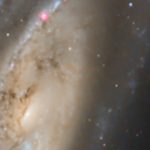 M106 also has significant hydrogen emission around the core – one of the brighter “jets” is just visible in the close up (at 150%) – taking hydrogen alpha data would show this up to a much greater extent, but this is something that will have to follow later when skies are clear!
M106 also has significant hydrogen emission around the core – one of the brighter “jets” is just visible in the close up (at 150%) – taking hydrogen alpha data would show this up to a much greater extent, but this is something that will have to follow later when skies are clear!
In June 1995, the following letter was published in Astronomy & Astrophysics from Burbidge concerning two bright Xray sources symmetrically placed about NGC 4258 (M106): 1995A&A…298L…1B
Burbidge found that these objects were in fact quasars, with redshifts of 0.39 (J1218+472) and 0.65 (J1219+473). Burbidge, who worked closely with Fred Hoyle, argues (as does Halton Arp in a later paper), that the association of these QSOs with M106 is not accidental, and that the redshifts arise from the ejection velocities of the objects from the host (pretty quick!).
All three scientists were strong proponents of non-Big Bang cosmologies though, so you may detect a slight bias here: later work (eg , http://iopscience.iop.org/article/10.1086/309327/pdf) appears to suggest one of these (J1281+472) is associated with a cluster at redshift z~0.3, and that X-Ray luminosity and cluster temperatures are entirely consistent. So, this may well be a case of line of sight.
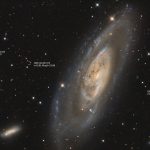 In the field as well (see the image, left), is a further QSO with redshift ~1.04 – theory places this at around 8Gly in a flat cosmology.
In the field as well (see the image, left), is a further QSO with redshift ~1.04 – theory places this at around 8Gly in a flat cosmology.
Image was taken with an ST2000XM through a 14″ Newtonian at f4.53 (fl = 1584mm) from West Oxfordshire on Feb 13th/15th 2018. Exposures lengths are:
Lum: 5h35m (56x5m + 21x3m)
R: 1h45m (21 x 5m, 2×2 bin)
G: 1h20m (16 x 5m, 2×2 bin)
B: 1h20m (16 x 5m, 2×2 bin)
The luminance data on its own is shown below.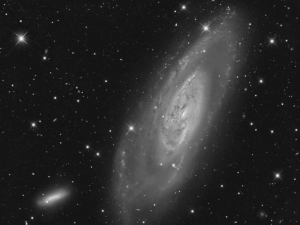
EDIT: This image was selected in 2nd place for the “A Galaxy, Far, Far Away” challenge on Stargazers Lounge – see: https://stargazerslounge.com/topic/314249-imaging-challenge-11-galaxies-winners/
![]() M106 in Canes Venatici by Graeme Coates is licensed under a Creative Commons Attribution-NonCommercial-ShareAlike 4.0 International License.
M106 in Canes Venatici by Graeme Coates is licensed under a Creative Commons Attribution-NonCommercial-ShareAlike 4.0 International License.
